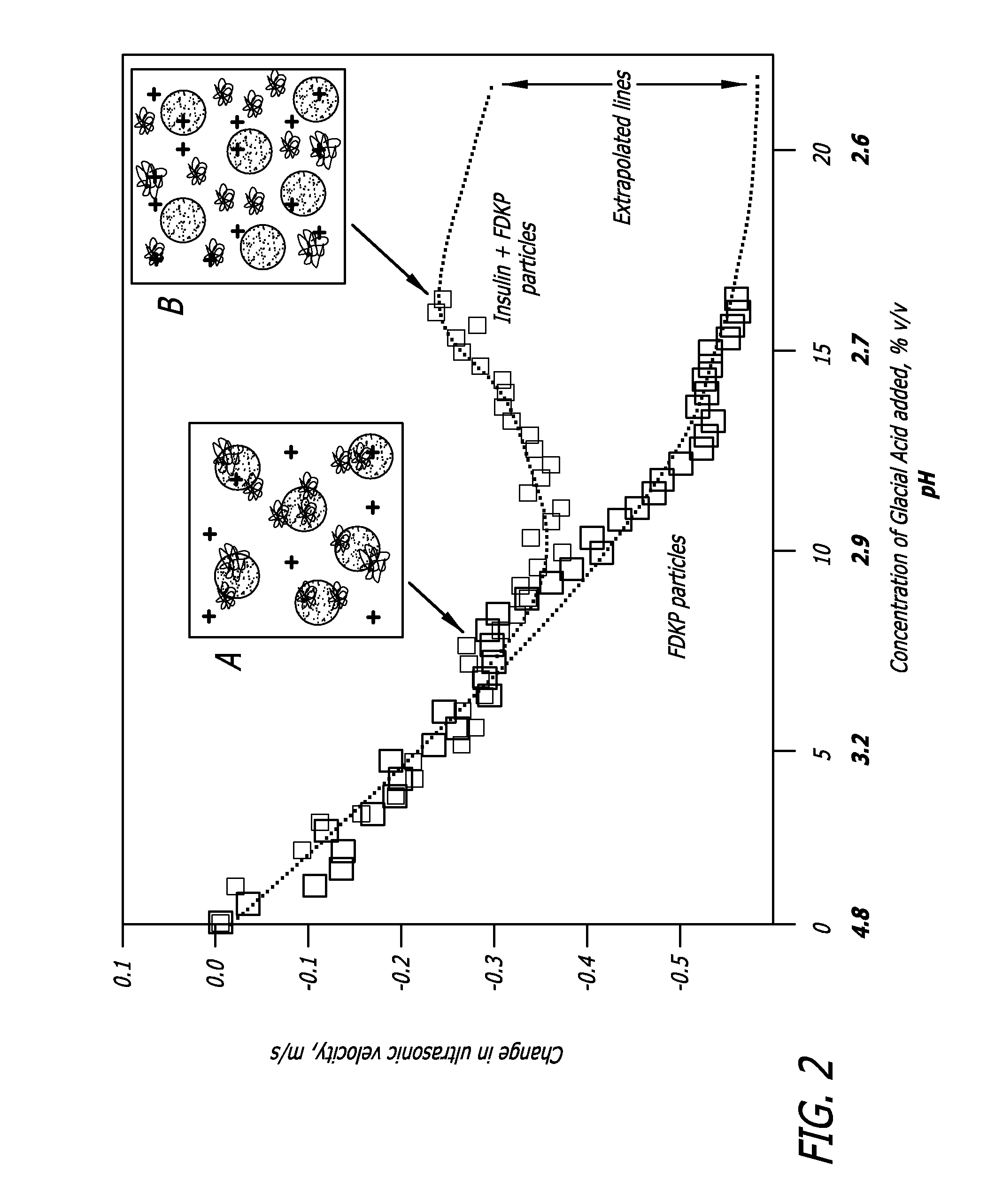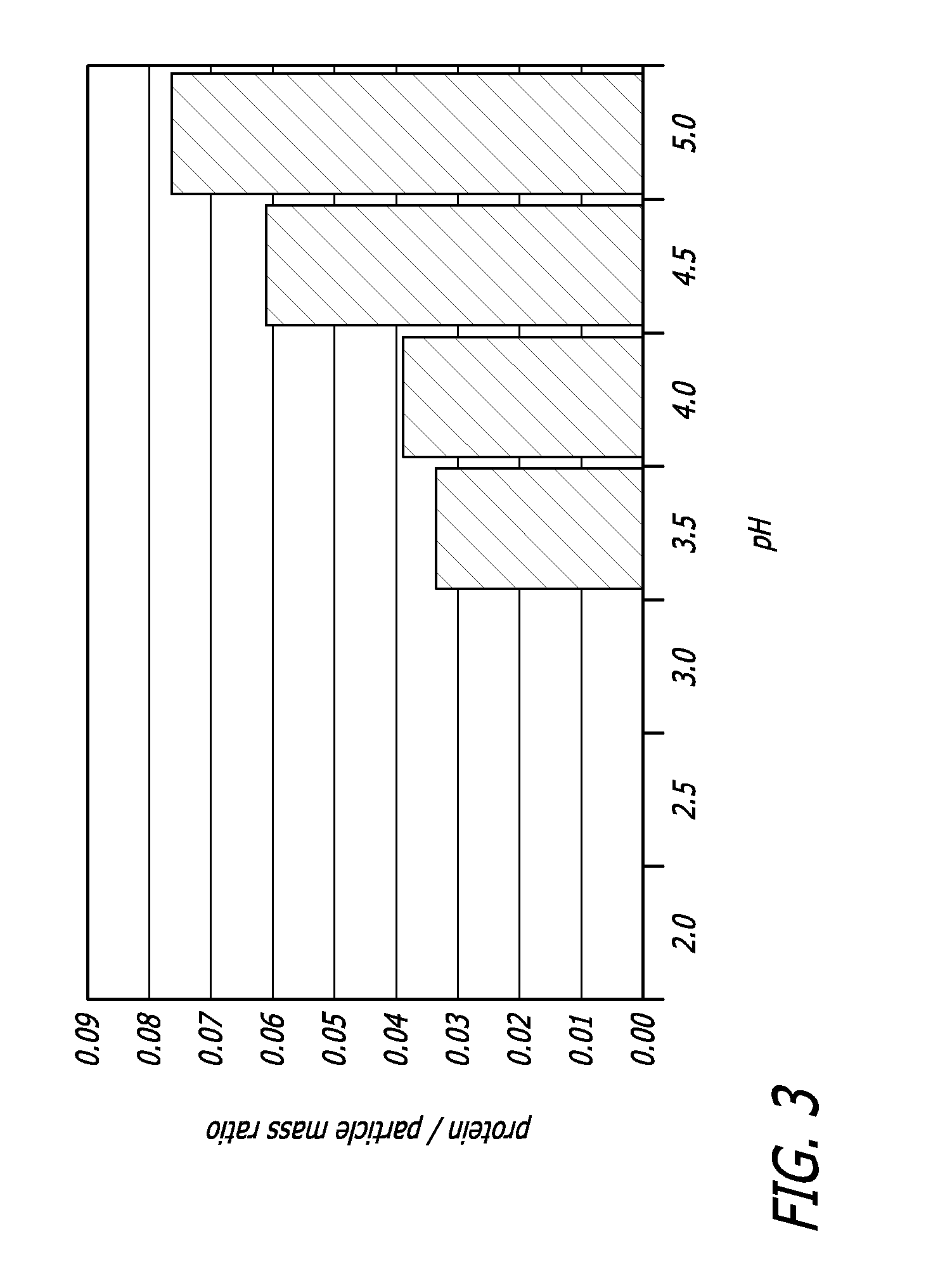Method of Drug Formulation Based on Increasing the affinity of Crystalline Microparticle Surfaces for Active Agents
a technology of crystalline microparticles and active agents, applied in the field of drug formulations, can solve the problems of inefficient adsorption of therapeutic agents, low or variable potency, and major problems in the delivery of therapeutic agents
- Summary
- Abstract
- Description
- Claims
- Application Information
AI Technical Summary
Benefits of technology
Problems solved by technology
Method used
Image
Examples
example 1
General Procedure For Loading Microparticles With Active Agents
[0061] Table 1 below is an example of electrostatically driven coating of an ionizable crystalline microparticle (FDKP microparticles) utilizing pH-controlled adsorption. In these experiments, FDKP microparticle suspensions were prepared at pH 2.0 and 4.5. Protein (growth hormone) was then added to each to give final conditions of 5 mg / mL FDKP particles and 200 μg / mL protein. After mixing, the bulk liquid was removed from suspension by filtration. The material trapped on the filter was then dissolved and collected. The protein concentration in all of the fractions was quantitated by HPLC.
[0062] At low pH (2.0), the protein did not adsorb to the particles and all protein was found in the first filtrate. By increasing the pH to 4.5, the surface properties of the particles were changed to have a high affinity for the protein. Under these conditions, the protein bound to the microparticles and was not seen in the filtrate....
example 2
Controlling FDKP Microparticle Ionization by Manipulating the pH
[0063] FDKP is a rod-shaped molecule with a carboxylic acid functional group at each end which is essentially insoluble in water below pH 3.5 when the carboxylic acids are protonated and carry no charge. The solubility of FDKP increases rapidly above pH 3.5 corresponding to ionization of the carboxyl groups. Modeling of FDKP crystals, which form as plates with two large, flat faces and narrow edges, indicates that the rod-like FDKP molecules align perpendicular to the edges of the plates so that the carboxylic acid ends of the molecule are arrayed on the large faces of the plates. On a theoretical basis, the surfaces of FDKP crystals should be partially ionized around pH 5.0, where the solubility is about 1 mg / mL, just below the pH at which a 10 mg / mL suspension of microparticles will dissolve.
[0064] The ionization of FDKP crystal surfaces has been observed indirectly with ultrasonic spectroscopy. In FIG. 1, the ultra...
example 3
Loading Protein onto FDKP Microparticles by pH Manipulation of the Surface Properties
[0066] The adsorption of proteins onto ionizable microparticle surfaces by pH manipulation can be achieved in two ways. The protein can be added and then the pH adjusted to cause ionization of the surface with concomitant adsorption of protein. This process is reversible. Alternatively the pH of the particle suspension can be adjusted to cause ionization of the surface before the protein is added.
[0067] The ultrasonic titration data shown in FIG. 2 indicates the association of protein (insulin) with the FDKP microparticles at pH greater than about 2.9 and reduced interaction at pH below about 2.9.
[0068] A suspension of FDKP microparticles was prepared in 20 mM ammonium acetate buffer, pH 4.8, and combined with an insulin stock solution to give 800 μL of suspension with a final concentration of 10 mg / mL FDKP microparticles and insulin concentration of 1 mg / mL. This suspension was introduced into a...
PUM
| Property | Measurement | Unit |
|---|---|---|
| Weight | aaaaa | aaaaa |
| Weight | aaaaa | aaaaa |
| Weight | aaaaa | aaaaa |
Abstract
Description
Claims
Application Information
 Login to View More
Login to View More - R&D
- Intellectual Property
- Life Sciences
- Materials
- Tech Scout
- Unparalleled Data Quality
- Higher Quality Content
- 60% Fewer Hallucinations
Browse by: Latest US Patents, China's latest patents, Technical Efficacy Thesaurus, Application Domain, Technology Topic, Popular Technical Reports.
© 2025 PatSnap. All rights reserved.Legal|Privacy policy|Modern Slavery Act Transparency Statement|Sitemap|About US| Contact US: help@patsnap.com



